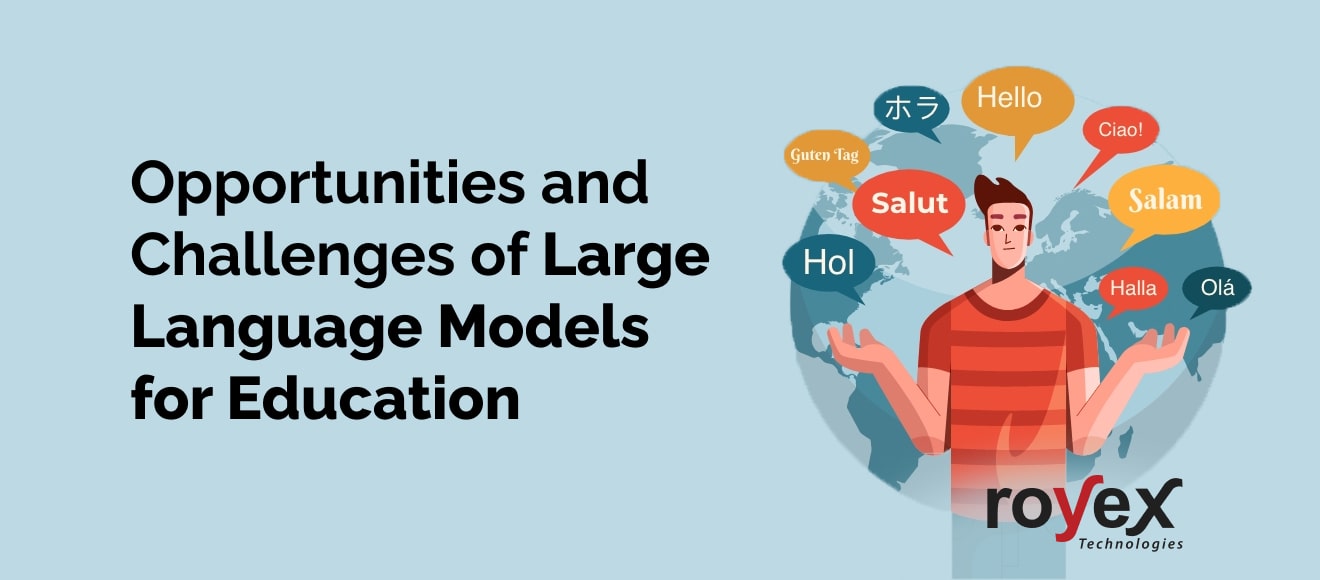
Opportunities and Challenges of Large Language Models for Education
In recent years, large language models (LLMs) have emerged as powerful tools capable of understanding and generating human-like text. The rise of large language models (LLMs) such as OpenAI's GPT, and Google’s Gemini has indeed sent ripples through every sector, and education is no exception. These AI-powered systems, trained on massive datasets of text and code, hold immense potential to revolutionize how we learn and teach. According to recent statistics, the global market for AI in education was valued at approximately $3.68 billion in 2021 and is projected to reach $25.73 billion by 2027, indicating a substantial growth trajectory and highlighting the increasing adoption of AI technologies in educational settings. However, despite their promise, LLMs present significant opportunities to enhance educational experiences, they also pose challenges that educators and researchers must address. This article delves into the opportunities and challenges of leveraging LLMs for education.
Unveiling the Opportunities
LLMs offer a treasure trove of possibilities for educators to enhance the learning experience:
Personalized Learning

LLMs can tailor educational content to individual student needs by generating customized explanations, practice questions, and feedback. Through natural language processing (NLP) techniques, these models can adapt to students' learning styles, preferences, and proficiency levels, thereby facilitating personalized learning experiences. Here's how they achieve this through Natural Language Processing (NLP) techniques:
-
Personalized Explanations
-
Tailored Practice Questions
-
Adaptive Feedback
-
Learning Style Recognition
-
Proficiency-Based Adjustments
Engaging Content Creation
LLMs enable the automatic generation of educational materials, such as lesson plans, quizzes, and instructional videos. By leveraging massive datasets of text and educational resources, these models can automatically generate engaging and informative materials. This frees up educators' valuable time, allowing them to focus on more crucial aspects of teaching, such as personalized instruction, interactive activities, and fostering a positive learning environment.
Here's a breakdown of how LLMs automate content creation:
-
Lesson Plan Generation:
Specify learning objectives and student demographics.
LLMs generate comprehensive lesson plans with:
Engaging activities
Assessments to gauge understanding
Differentiated instruction strategies to cater to diverse learning needs
-
Effortless Quiz Creation:
Ditch the time-consuming task of writing individual questions.
LLMs can create quizzes that:
Target-specific learning objectives
Offer a variety of formats (multiple choice, true/false, open-ended)
Adapt to different learning styles
-
Instructional Videos on Demand:
Imagine feeding an LLM a text script and having it produce:
An engaging instructional video
Complete with narration, visuals, and interactive elements
-
This can revolutionize the creation of multimedia learning resources.
Language Learning
LLMs offer immersive language learning experiences by simulating real-world conversations and providing instant feedback on grammar, vocabulary, and pronunciation. Students can engage in dialogue with virtual language tutors powered by these models, enhancing their linguistic skills in a naturalistic setting.
Large language models (LLMs) are making language learning more immersive and engaging than ever before. Here's how:
-
Personalized Learning Experiences
-
Instant Feedback Mechanisms
-
Interactive Language Tutors
-
Adaptive Learning Pathways
Accessibility

LLMs have the potential to make education more accessible to diverse learners, including those with disabilities or limited access to traditional educational resources. Text-to-speech and speech recognition capabilities enable students with visual or auditory impairments to engage with educational content more effectively.
Text-to-Speech (TTS) Technology:
-
LLMs incorporate advanced text-to-speech technology that converts written text into spoken language.
-
Students with visual impairments can benefit from TTS functionality by listening to educational materials, including textbooks, articles, and instructional content, in audio format.
-
TTS enables equitable access to educational resources, allowing visually impaired learners to engage with course materials independently and effectively.
Speech Recognition Capabilities:
-
LLMs are equipped with speech recognition capabilities that transcribe spoken language into written text.
-
Students with auditory impairments can utilize speech recognition technology to communicate, participate in discussions, and interact with instructors in real time.
-
Speech recognition facilitates inclusive learning environments by enabling students with auditory impairments to engage actively in classroom activities and collaborative learning experiences.
Multimodal Learning Interfaces:
-
LLM-powered educational platforms offer multimodal learning interfaces that accommodate diverse learning preferences and accessibility needs.
-
Students can choose from a range of modalities, including text-based, auditory, and visual representations, to interact with educational content and complete learning tasks.
-
Multimodal interfaces enhance accessibility by providing flexible and customizable learning experiences that cater to individual learning styles and needs.
Alternative Formats for Content Delivery:
-
LLMs support the creation of alternative formats for content delivery, such as braille, large print, and accessible digital formats.
-
Students with print disabilities, including dyslexia or other reading difficulties, can access educational materials in formats that suit their needs and preferences.
-
Alternative formats enhance the accessibility of educational content, empowering students with print disabilities to engage with course materials effectively and independently.
Universal Design Principles:
-
LLM-powered educational resources are designed using universal design principles, ensuring accessibility for all learners, regardless of their abilities or disabilities.
-
Features such as customizable font sizes, color contrast options, and navigational aids enhance usability and readability for students with diverse needs.
-
Universal design principles promote inclusive learning environments that accommodate the diverse learning needs and preferences of all students.
Research and Development
Large Language Models (LLMs) are powerful tools for researchers studying education. They help researchers understand theories about how people learn and validate ideas about teaching methods. With LLMs, researchers can analyze lots of educational texts and data, finding trends that shape effective teaching practices. LLMs also help researchers look at large sets of data about how students learn, like their engagement and performance. By using LLMs, researchers gain insights into what factors help students succeed in learning. This helps them create personalized teaching methods and make informed decisions about educational policies. Additionally, LLMs can predict future trends in education by analyzing past data, helping researchers plan interventions to improve student outcomes.
-
Exploration of Educational Theories
-
Analysis of Learning Patterns
-
Development of Innovative Teaching Methodologies
-
Insights for Evidence-Based Practices
-
Prediction and Forecasting Models
Navigating the Challenges
Despite the exciting possibilities, LLMs present significant challenges that educators need to address:
Bias and Misinformation
LLMs trained on biased datasets may perpetuate stereotypes or marginalize certain demographic groups in educational settings. Addressing bias and ensuring fairness in LLMs requires careful dataset curation, algorithmic transparency, and ongoing evaluation of model outputs to mitigate unintended consequences.
Ethical Use
The use of LLMs in education raises ethical concerns regarding data privacy, consent, and responsible AI usage. Educators must navigate ethical dilemmas related to student data protection, algorithmic transparency, and the potential for algorithmic harm, such as misinformation or manipulation.
Digital Divide
Access to LLM-powered educational tools may exacerbate existing inequalities in access to technology and digital literacy skills. Students from underserved communities or resource-constrained regions may face barriers to accessing and utilizing LLM-enhanced educational resources, widening the digital divide.
Teacher Training
Integrating LLMs into educational settings requires substantial teacher training to effectively utilize these tools and interpret their outputs. Educators need support in understanding LLM capabilities, designing pedagogically sound learning experiences and scaffolding student interactions with these models.
Evaluation and Validation
Assessing the effectiveness and impact of LLMs on learning outcomes poses challenges due to the dynamic nature of AI-driven educational interventions. Rigorous evaluation frameworks and longitudinal studies are needed to measure the efficacy, scalability, and sustainability of LLM-based educational interventions over time.
The Road Ahead

LLMs are here to stay, and their impact on education is undeniable. By harnessing their potential while mitigating the risks, we can create a more personalized, engaging, and effective learning experience for all students. Here are some key steps to ensure responsible integration of LLMs in education:
-
Developing digital literacy: Equipping students with the skills to critically evaluate information from LLMs and understand their limitations is essential.
-
Teacher training and support: Teachers need proper training on using LLMs effectively and integrating them seamlessly into their curriculum.
-
Ethical considerations: Developers and educators must prioritize ethical considerations throughout the design and implementation of LLM-based educational tools.
In conclusion, large language models offer unprecedented opportunities to transform education by personalizing learning experiences, automating content creation, and enhancing accessibility. However, realizing the full potential of LLMs in education requires addressing challenges related to bias mitigation, ethical use, digital equity, teacher training, and evaluation. By collaboratively addressing these challenges, educators, researchers, policymakers, and technologists can harness the power of LLMs to create inclusive, equitable, and effective educational environments for learners worldwide.





